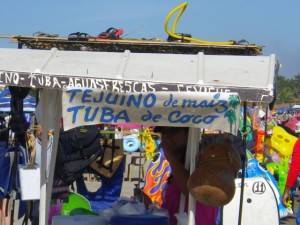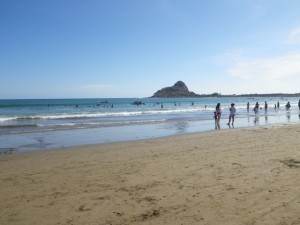This week is Semana Santa (Holy Week) and the Mexicans are on holidays. I was warned that the beach will be standing room only by the weekend and that I should plan to hunker down. I decided that since today is likely to be the last day before the madness truly starts, I would go check out what was what on the beach.
All the vendors and signage are for Mexicans, not Gringos, most of whom have left already anyway. It’s nice to be in such a touristy area and still experience something authentically Mexican.
I will confess I was getting flashbacks to the movie Jaws, just before the Kintner boy is killed…

Finally, a chance to photograph this sign as a reminder to Google what the heck tejuino and tuba are!
Tejuino is a fermented drink made from corn juice. Tuba is palm wine. So both are very mildly alcoholic concoctions.
To my surprise, I saw my friend N playing in the surf, so I joined her, glad I was wearing suitable clothing for that! I had a few things to discuss with her, so that worked out really well.
I don’t normally bring money on my walks, but I had thought to stop at a restaurant for a limonada mineral and so had a little cash. Instead of waiting for ages at one of the crowded restaurants, I decided to check out what a ‘raspado’ is at there were a lot of vendors for them. I knew that shaved ice was involved.
That’s the base and you can add fruit juice with chunks of fruit, spices, caramel, sweetened condensed milk and more. I asked for a simple pineapple one and the cost was 20 pesos. Folks who got caramel and milk paid 25 to 30 pesos.
The ice comes in a huge block that is kept in a garbage bag. There’s a tool for shaving it that also collects the shavings into a neat shape that can be easily packed into a glass.
The man spoke some English, but was happy to switch to Spanish and said, “You must be Canadian.” I asked how he knew and he said that it’s easy. According to him, the Americans never buy from food carts, but Canadians often do. I shrugged and said that I’ve been here for almost six months and the food has yet to make me sick, much less kill me!
The raspado was wonderful and refreshing, with a generous amount of pineapple. I may seek him out again to try a prune one!
As I was reaching my turn off to go home, Paco, the jewellery vendor, came up to me and said, in English, “I’m not selling, just want you to look at more snake rings.” I did and didn’t like what he had as they were much bigger than the one I bought, which is already the limit of how big a ring I’ll wear since I have to be able to type with it. He proved to me that he really wasn’t trying to sell when he said, “Okay. See you again soon,” and turned to leave.
So I surprised him by asking if he had earrings, he opened up his case, I had a gander, and we struck a deal for delicate dragonflies with iridescent blue stones that he again confirmed are not real silver, but which are lovely nonetheless. He was really surprised and pleased to make a sale!
I’m glad I got a peek at what Semana Santa is like on the beach, but I’m not convinced I’ll be heading there over the weekend, other than to perhaps sneak a few pictures from a distance!


















Baños y regaderos = toilets and showers
Thanks! That’s what I understood, but what an odd choice of word!
Must be Mexican vernacular. Regadera was the word for shower when I was there. They didn’t use ‘ducha’ except sometimes as the verb ‘ducharse’.
Yup, definite Mexico slang. I had to purposely Google regardera + Mexico to get to the shower meaning.
When I saw the sign, I assumed it meant access to a cold fresh water spray for rinsing off, so I got the general gist of it.
I always use ducha and my landlady has yet to ‘correct’ me on that. She’s very good at teaching by example. If regadera was the correct or usual Mexican term for a shower, she would have had me figure that out by now by using that term, but she also calls it a ducha. So more research needs to be done to figure out if ducha is really not used much. Interesting!
Based on my own experience, regadera means showerhead, i.e., the thing the water comes out of. Otherwise, everyone I know in Mexico uses ducha. Maybe if these showers were outdoor, beach-y affairs, they are considered more just regaderas than full showers?
Saludos,
Kim G
Boston, MA
Where regaderas are also connected to the ends of hoses for watering plants.
A regadera is a watering can or sprinkler. A shower head is an alcachofa de la ducha, literally shower artichoke! My landlady laughed so hard the time I told her I needed the part of my shower named for a vegetable fixed!
Truck stops in MX along the 15 tend to have showers and they are called ‘regarderas’ as well. Until I realised that, I would have completely agreed with you about the distinction between a regardera and a ducha. Now, I’m more confused!
Alcachofa de la ducha is the term used in Spain. I’d never heard it until you mentioned it, and then I went digging on wordreference.com. And as you know, there are plenty of British usages of English that would raise eyebrows or stares of confusion if used in Canada or the USA. Or in reverse. A British friend once told me that the Brits thought the title of the movie “Free Willie,” was a complete riot. Of course, in British English, it is, and certainly wouldn’t be something you’d think to take children to.
As for regadera, I’ve heard it used as I described, but your own mileage will vary. Even within Mexico, there are different usages in different parts of the country. And with no Mexican Real Academia Española, anything goes!
You can find an amusing discussion here: http://forum.wordreference.com/threads/regadera.577824/
Saludos!
Kim, I absolutely delight Mexicans because I learned Castilian Spanish and have a flawless European Spanish accent. Within a couple of weeks here last year, a very kind neighbour told me that folks were having trouble with my accent and that I sounded to them the way Queen Elizabeth would sound to Americans. She gave me a few tips for toning down my accent and that made a huge difference. I am so grateful that she told me that! I thought I was just making a bunch of mistakes, but as soon as I cut down on the amount of lisping I was doing (saying ‘ser-bvay-sa’ rather than ‘ther-bay-tha’, for example), boom, I was intelligible!
But I also have vocabulary differences that are akin to lorry and rubber versus truck and eraser, like using melocotón instead of durazno, zumo instead of jugo, conducir instead of manejar, etc. I do know better than to use the verb coger on this side of the pond!
I actually read that forum thread last year after I posted this! LOL